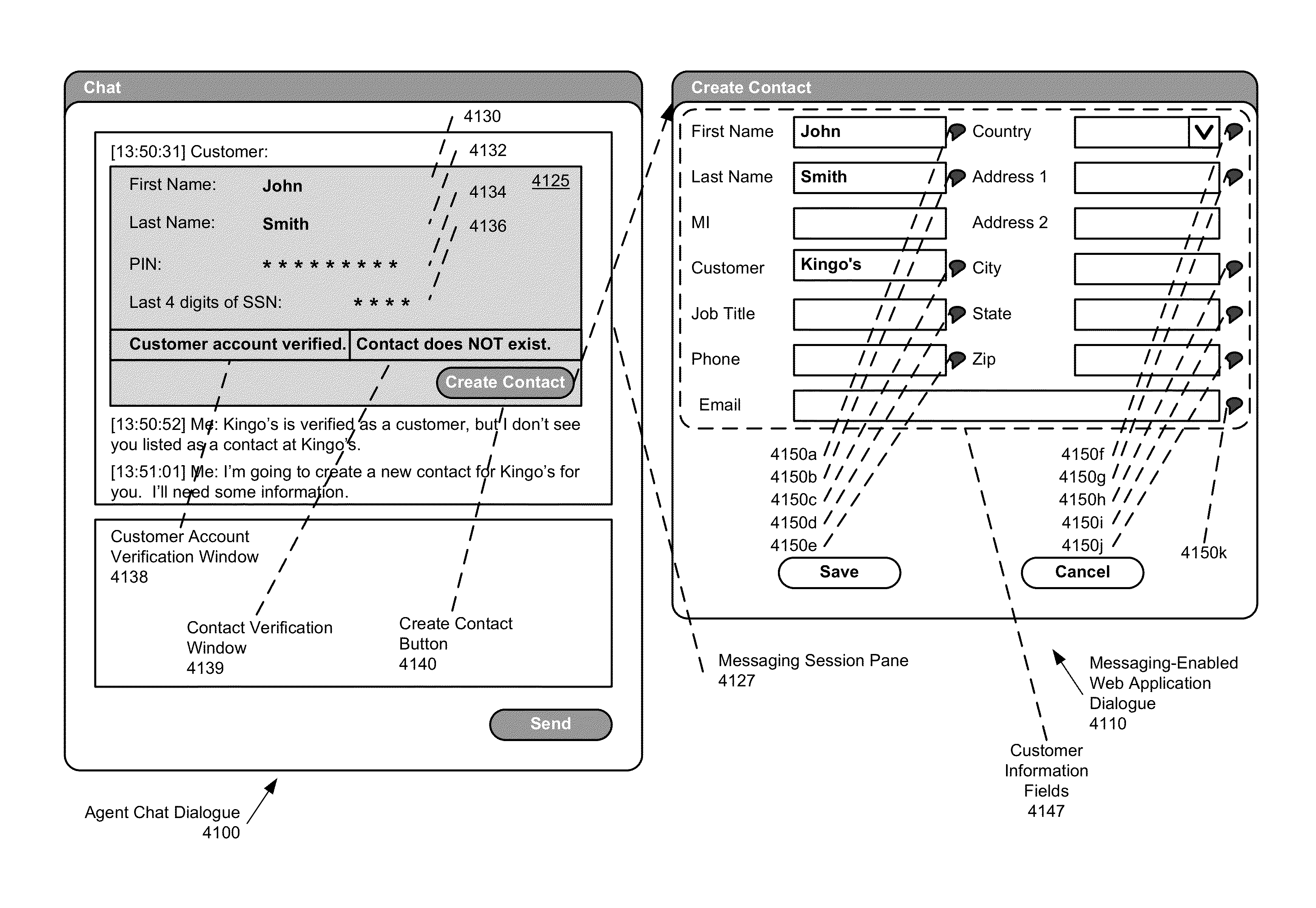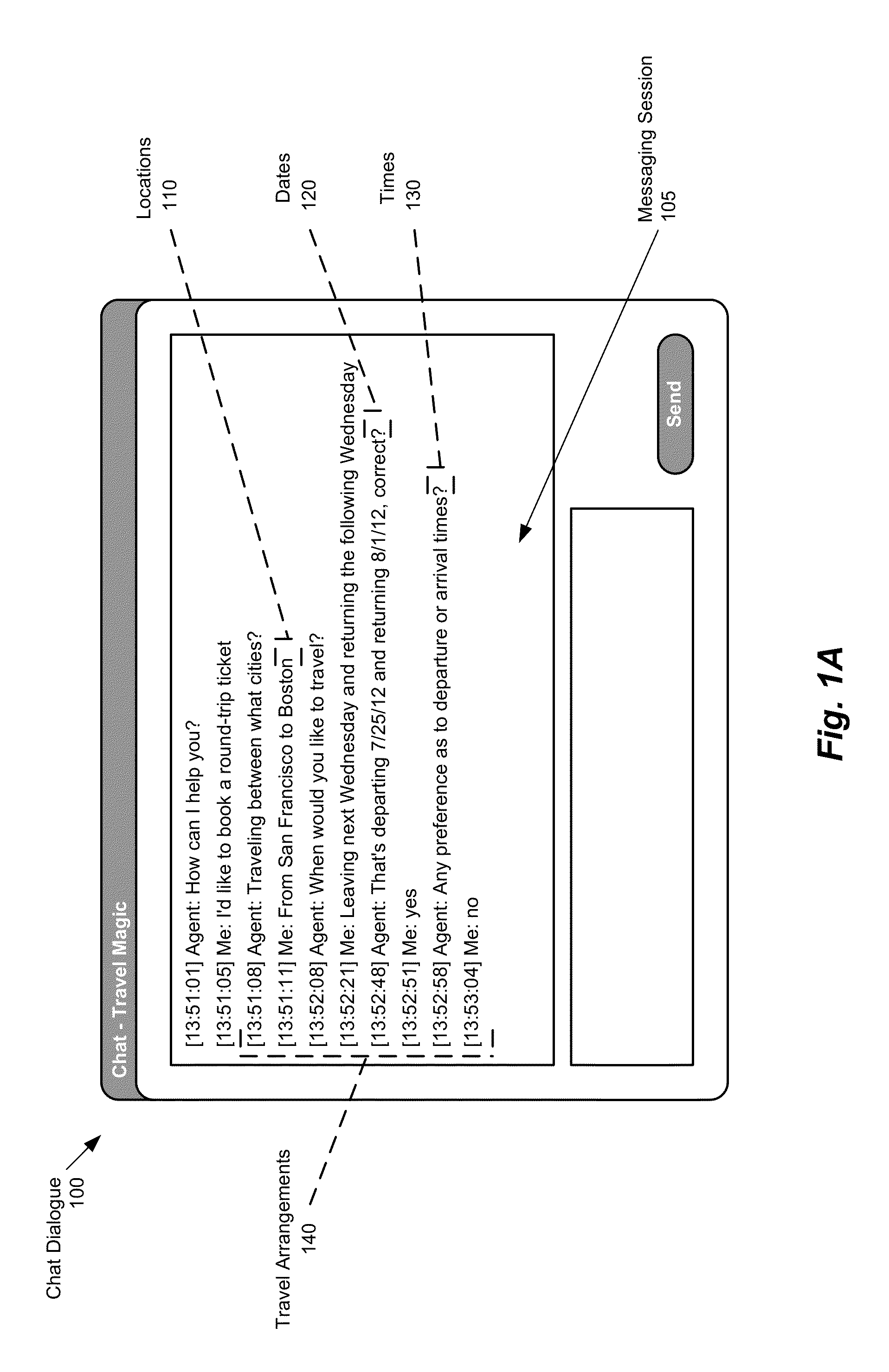However, despite the advanced features offered by today's messaging systems, the available technologies fail to adequately address certain aspects of messaging systems in a variety of applications, as well as the needs of users employing such messaging systems.
One shortcoming of today's messaging systems is that such systems fail to provide an easy-to-use mechanism for conveying information between such systems and other applications the messaging system user may employ.
For example, chat data is not integrated into the systems used, requiring many copy-and-paste operations.
This is particularly problematic in commercial settings, where, for example, a customer service representative typically conducts several conversations simultaneously, and thus may have not only several messaging dialogues open at once, but also some number of application dialogues.
Clearly, keeping track of so many dialogue windows (and which ones belong to which conversation) can be tremendously challenging.
Further, the other party's response may not be formatted properly and / or contain the proper information for use by the application program employed.
This requires mental
processing and re-
typing of the information into the application program's dialogue, further complicating the process.
However, such an approach is not without its problems.
For example, a pre-chat survey creates a barrier between participants (e.g., a customer service agent and customer) by forcing one or more of them to complete such a questionnaire prior to communicating with other participants, potentially causing the customer to abandon the messaging session before the session has even begun.
Further, a pre-chat survey cannot be used during a messaging session, only beforehand.
Having to wade through a number of questions (some of which may be completely irrelevant to the user and their situation) only serves to frustrate users and discourage them from using the messaging system to communicate with other participants.
However, this alternative also suffers from a variety of drawbacks.
Such problems include a lack of security (both / all users can see the information entered, as discussed in greater detail subsequently), the need for a separate
web page (which results in the messaging session becoming fragmented), the mandatory presentation and completion of the entire questionnaire (with the attendant problems thereof, including increased complexity and overhead for both parties), and the resource-intensive nature of such an approach (having to load / view / complete a completely separate
web page / document), among other such shortcomings.
Further, the aforementioned
cut-and-paste features are only useful in personal
collaboration when both parties can see and access the same form—a situation that can prove problematic.
In the CRM context, for example, sharing the agent's forms with customers can be particularly awkward because such forms are configured to address the agent's needs, not those of the customer (and may, in fact, allow a party to see information meant solely for the other party's use).
Moreover, because the shared interactive
web application and the messaging window must be presented in two separate browser windows, mobile users are unable to view the message communications when interacting with the shared interactive
web application.
However, opening such documents in windows separate from that of the messaging session fragments the conversation (causing inefficiency, errors, and, ultimately,
frustration), and fails to provide a single, comprehensive view of the messaging session.
Such problems only become worse as the number of such documents (and so, windows in the
user interface) are opened.
Further, existing solutions define supported types of documents must be defined prior to the messaging session, causing the same issues as those faced by approaches employing a “pre-chat survey.” If no such document is defined prior to the messaging session, communications devolve into the usual unstructured format (with the attendant problems such systems are intended to address).
Further, given that one or more communications channels other than the primary communications channel are employed (i.e., the messaging system), no
record of such communications are maintained (at least with regard to recording mechanisms extant in the primary communications channel).
As alluded to earlier, another
usability problem encountered in the design and operation of messaging systems pertains to security and privacy concerns.
Even though the security of a messaging session may be guaranteed by the
networking protocol employed, messaging system users often express concern over security and privacy issues, at least because such information appears as
plain text in the messaging session's transcripts (rather than being masked, as would normally be the case when completing web forms).
In this regard, users of such systems suffer from the loss of a sense of security, in that sensitive information (e.g., social security numbers, passwords, and other such sensitive information) is not masked or otherwise protected.
As noted, such an approach is something less than ideal, causing fragmented and confusing interactions, thereby causing errors and compromising
user satisfaction, among other failings.
Another approach is to provide messaging services only to authenticated customers (but not to the general public), thereby drastically restricting the use of such communications and preventing the general use of such communications (in particular, without the need for a priori information, such as a username and
password for the site).
Even if such masking were achievable, there would be no opportunity to edit a response, once the information was submitted into the messaging session (in fact, a problem faced by all existing techniques that submit information into a messaging session).
Further, such identification and masking experiences errors with regularity sufficient to raise users' concerns.
Further still, the use of
pattern matching typically fails to comprehend sensitive information that does not have a specific pattern (e.g., certain account identifiers, passwords, and other such information that varies in length and content).
 Login to View More
Login to View More  Login to View More
Login to View More 


